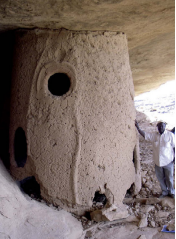Katy Meyers
Source - http://www.bonesdontlie.com/
The rise of social complexity is in interesting phenomenon. We’ve discussed before how cemeteries can be used to determine differences in social status and groups using the artifacts, burial placement and human remains to locate patterns. Over time though, these relationships shift, and in general they become more complex. Instead of status being based in the household, with older and more dominant family members being recognized as higher than other family members, certain family groups become recognized as higher than other groups. The divisions between high and low increase in complexity to include a variety of levels and statuses. Connections are made at a broader scale, and networks expand to larger groups. Once again, cemeteries can provide an important glimpse into these changes. Not only can we identify differences in social status, but we can see the change over time in how these different groups change and shift.

Dogon Country, Mali, cliffside villages, via Flickr user Frank in Guinea
A new study by Mayor et al. (2014) examines burial trends within Dogon Country, Mali. Early excavations revealed collective burials in rock shelters dating from the 11th to 16th centuries CE. The caves were protected by walls of mud-brick, stone wrapped in clay or wooden pillars. The deceased would be dressed in a blanket, and were accompanied by offerings and personal objects. Prior to use as burial chambers, the caves were thought to have been used as granaries beginning in the 3rd to 2nd century BCE based on the presence of clay constructed coiled towers within the caves. The chronology created from these caves was based on three major time periods: Toloy, the 2nd millenium BCE occupation, a major gap in occupation then Tellum, the 11th to 16th CE century occupation, and Dogon, the most recent. There are major gaps in the time, and little understanding of how these groups developed. Mayor et al. (2014) re-examine the evidence from the rock shelters in order to better understand how these burial trends developed and how social complexity emerged in this group.

Granary/tomb from Mali, via Mayor et al. 2014
They meticulously excavated three funerary sites from the area, carefully surveyed the rock shelters, sampled human remains, and investigated the related funerary structures. Numerous samples were taken from structures and graves in order to do radiocarbon dating to create a more accurate timeline of use. Radiocarbon dating revealed a much wider timeline for the constructed granaries, and showed they were built from the 5th century BC E all the way up to the 6th century CE. They reanalyzed the materials found in the ‘granaries’ and found that they contained little evidence for use in storing grain, and were unlike other grain holding structures from the region. The presence of bone within them led them to conclude that these were also funerary structures.
Mayer et al. (2014) propose a new sequence of funerary behavior development for this region based on the discovery that the supposed ‘granaries’ are actually tombs. First, there are spindle shaped coiled tombs found centrally within rock shelters that date from the 5th century BC E and the 1st century CE. Second, there are more circular clay tombs along the circumference of the rock shelters dating from the 1st century BCE and the 2nd century CE. Third, there are circular coiled tombs with sealants found in a single rock shelter dating from the 3rd to 6th centuries CE. This finding means that the tombs have been used for much longer than previously thought as tombs, and also that there is no gap in the use of this region between the Toloy and Tellum cultures as was previously thought. Analysis of all the evidence reveals that this region had almost 4,000 years of continuous human occupation.
The presence of this behavior of creating coiled tombs throughout the region and over a long period of time indicates that there was a strong cultural identity within this area, and that groups were not isolated but rather shares material artifacts and funerary architecture construction techniques. The development of these tombs and the associated artifacts reveals that there is no major gap in occupation, and that social complexity emerged locally.
Personally, I love these kinds of findings. It is great to see a major shift in thinking about the development of a region based on one minor shift- they aren’t granaries, they are tombs. It will be fascinating to see how this shift in thinking changes the broader interpretations of this region.
Works Cited
A. Mayor, E. Huysecoma, S. Ozainnea,c, & S. Magnavita (2014). Early social complexity in the Dogon Country (Mali) as evidenced by a new chronology of funerary practices Journal of Anthropological Archaeology, 34, 17-41 DOI:10.1016/j.jaa.2013.12.002